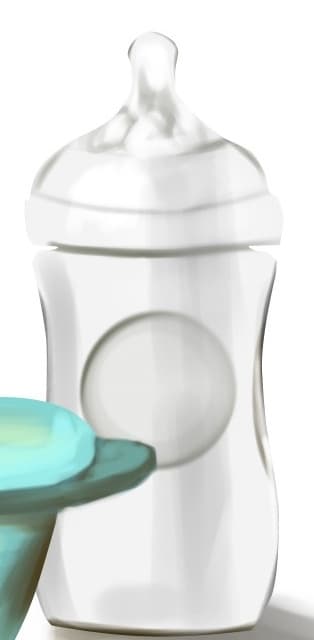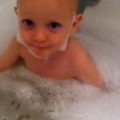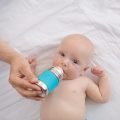All bottle-feeding moms want the best non-toxic baby bottles for their babies, whether the bottles are is filled with breastmilk or formula or even water. Here’s how to make sure you’re using truly non-toxic baby bottles.
1. Avoid Plastic Baby Bottles (including “BPA-free” ones!)
Plastic bottles are tempting—they are inexpensive, readily available, lightweight, and hard to break. But plastic leeches chemicals, some of which are known endocrine disruptors (hello, BPA!).
Don’t be fooled by “BPA-free” labels. BPA-free plastics that contain BPA substitutes like BPS are possibly just as bad, if not worse. Bottom line: If you want non-toxic baby bottles, you’ll never be buying any kind of plastic.
2. Choose Glass or Stainless Steel Baby Bottles
The safest baby bottle material is probably glass. Glass bottles won’t leech anything into milk or formula. Whenever possible, choose glass for breast milk storage, too.
Food-grade stainless steel is a close second to glass. Stainless steel bottles are lighter and less breakable than glass. We love Pura Kiki infant bottles because they are totally plastic-free, come in two sizes (5 oz and 11 oz), are available insulated and non-insulated, and can be converted into bottles for toddlers, kids, and adults.
3. Silicone Baby Bottles Are Okay
Silicone baby bottles are better than plastic, but probably not as safe as glass or stainless steel; research on the safety of silicone is relatively limited. We do know that silicone may leech at very low and high temperatures, so you might consider skipping silicone bottles for hot liquids and avoid putting them in the freezer. I like the Comotomo Natural Feel silicone bottle. (Note: (These silicone bags are better than storing breast milk in plastic.)

4. Don’t Forget the Nipples
Food-grade silicone is probably the safest, most durable and hygienic material for baby bottle nipples. A close second is natural rubber nipples from a credible company like Hevea or Natursutten. Definitely skip synthetic latex nipples (like these by Gerber), which can contain a number of concerning additives.
Because my babies rarely drank from bottles, I can’t recommend a favorite in terms of efficacy. That’s why I need you guys to comment below on your favorites glass, stainless steel, and silicone baby bottles and nipples–please do so below!
Stay sane,

If you liked this post, sign up for our newsletter to be alerted when we publish new content like this!









Kristin says
I really wanted to do glass bottles with baby #2, but daycare said it was against DHS policy to have glass bottles, so we went with the silicone Comotomo. They work great for breastfed babies. My son didn’t get a bottle until he was 4 months old, and it took him a week at daycare before he would take one. We borrowed several different kinds from friends, and Comotomo was the only one he would take. He pretty much never gets a bottle at home, but if he did, I would use the glass Mason bottle (basically a mason jar with a nipple on top).
For the nipples, just keep in mind that a breastfed baby does not necessarily need a faster flow nipple as he gets older. Mom’s nipples don’t change, so no need to change the bottle nipple!
Amy says
I love the Evenflo classic glass bottles….well I should say my 6 month old loves them…lol. We have them in both 4oz and 8 oz size and they work great. Very affordable! and their slim profile makes it easier to stack in the cabinet. I also love the life factory ones with the silicone sleeves for daycare.
Crystal says
A previous discussion on this topic referenced Mason Bottles. You use a regular mason jar and buy the silicone nipples. They are fantastic. Can go in the freezer. Most other glass bottles use plastic nipples.
Maia James says
what a great idea!
Anne says
Maia, I’m in the same daycare situation—we have to use plastic—and am also needed by to store that milk in the freezer. What do you recommend?
Sonia says
Question! You don’t explain why stainless steel is a close second to glass and I am curious to know where stainless steel lags. I am mostly curious because I would be so afraid of the glass breaking and also since it is so heavy the baby, I assume, wouldn’t be able to begin to hold it as early as they would be able to because it is so heavy.
Thanks!
Maia James says
Hey! I personally feel that stainless steel is entirely safe, but there is some concern that with heated or acidic liquids, small amounts of nickel might leach. You can learn more about stainless steel here: https://gimmethegoodstuff.org/safe-product-guides/cookware/
Sonia says
Excellent, thanks!
Aga says
Does anyone know what are Philips Avent natural nipples made of? I can’t find that information anywhere. I have a set of glass bottles on my baby registry list because I know I want to use glass bottles only. Same question goes for Dr Brown’s nipples. They all say BPA free. But what is the material they’re made of? Thank you 🙂
Maia James says
They are made of silicone….which means they are safe;)
Jessica says
Do you have a guide on safe pumping and breastmilk storage? I’m using comotomo bottles, but I’ve been concerned about storage since my son was born.
Stacy says
I do not know that you can avoid plastic with pumping unfortunately but I stored my milk in 4 oz mason jars. I did pump into the plastic medela bottles but transferred when I got home.
Danielle says
Hi there, if you are using a Medela pump, the lifefactory bottles fit it!! What a lifesaver. I pumped into those and stored it right in there or dumped into larger 16oz mason jars. Hope this helps!
Robin J. says
I’m using Evenflo glass bottles currently and used them with my first as well, about half way in once I learned of the dangers of plastic. They are the cheapest out there! And do not break easily. Only 2 broke through 2 babies. And you can pump directly into them as they fit with medela pump parts. For storage, I’ve frozen bottles themselves, using the stopper plastic cap (no contact w the milk)…and I’ve also had great success with Anchor or pirex glass containers. They fit 5oz comfortably with room for expansion…and are reusable for many food needs.
Maia you mention silicone having dangers in the freezer…does this deem silicone food pods unsafe? We’ve always used them for freezing homemade baby food, what a true bummer. Even food grade silicone is unsafe for this purpose?
Erika says
Thankyou for this. You don’t say why silicone teats are better than rubber. What are the health and environmental benefits and risks of the two? Thankyou!
Jen says
I love my Joovy Boob glass bottles. The come with silicone nipples and a silicone sleeve which can be removed if need be. I’ve dropped them several times and they did not break.
For the people who can’t use glass because of day care, I would suggest using stainless steel.
Mel says
I use plastic at daycare but try to use glass at home. The avent specifically. I like to make them hot/warm tea with milk so for that reason I don’t like stainless.
For my next kid I will be more strict about no plastic as I know a little better. But I still use a plastic sippy cup for my oldest and her Warm (chamomile) tea with milk in the morning and I do need to figure out a switch she will tolerate. For now I make the tea in a cup and pour half a cup of cold milk in the sippy then add the hot liquid.
For my next one coming soon I’ll stock up on glass. What’s the cheapest bottle that’s glass?
Suzanne Weaver-Goss says
Hi Mel,
Good for you getting away from plastic. As you know we offer the Pura Bottle which is stainless steel. https://gimmethegoodstuff.org/store/pura-kiki-stainless-steel-infant-bottle-5oz/ The prices of glass bottles fluctuate so I am not sure what the cheapest one is. Perhaps sometime in the near future we will offer glass bottles.
Joy says
I hope all will consider lead when choosing ANY bottle, sippy cup or feeding tool for their children. Tamara Rubin has done quite a bit of independent lead testing and Pura Kiki has tested positive many times: https://tamararubin.com/category/pura-kiki/
As have quite a few glass bottles: https://tamararubin.com/?s=baby+bottle
Always good to cross reference as many resources as one can find. Unfortunately, just because something is glass or stainless doesn’t mean it is lead or cadmium free which makes a product made from silicone or even plastic (assuming they are lead free) sometimes a better choice if they are your only options, In my opinion.
Maia James says
You can see our response to Tamara’s concerns in this post: https://gimmethegoodstuff.org/safe-product-guides/sippy-cups/